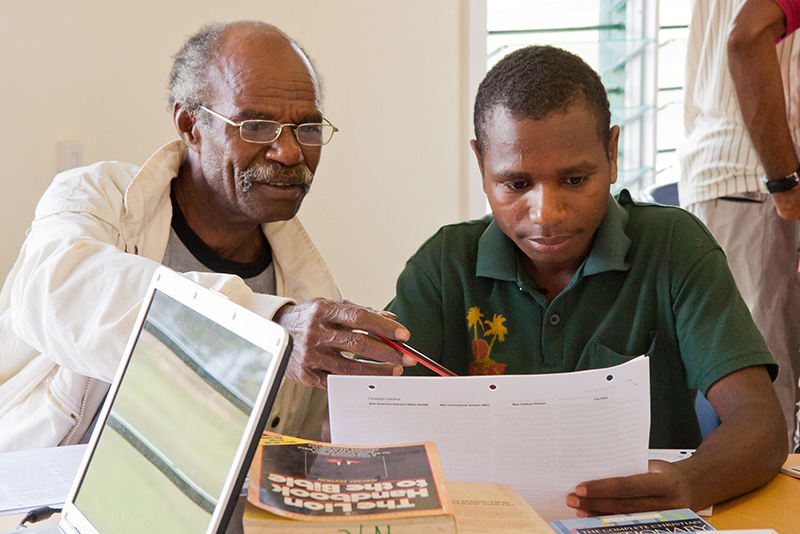Google can do so many things: resolve dinner table arguments, magically change its logo on the daily and even anticipate what question I’m going to ask next.
But one thing Google can’t do is translate the Bible. We’ve already looked at five reasons why it just doesn’t work (see previous blog), and now it’s time to explore even more reasons why Google and other computer programs can’t come close to replacing the work of human translators.
-
1. LET’S START AT THE VERY BEGINNING.
Once upon a time. It was a dark and stormy night. “In the beginning God created the heavens and the earth” (Genesis 1:1, NLT).
Every great story has a strong beginning that sets the scene for what’s to come, and the Bible is no exception. The first verses of Scripture are important to understand the rest of the Bible because they set the foundation to learn who God is: the Creator of the universe.
When the Teribe translation team in Panama translated Genesis 1:1, they took a literal approach by communicating that God made “the top of the sky” (heavens) and “the dirt” (earth). After all, that’s exactly what the Hebrew text states!
But the Teribe people understand the world by breaking it into three parts: sky, dirt and water. So when the team presented the translated verse to the local community to see how they interpreted Genesis 1:1, an issue quickly came to light. When asked if there was anything that God didn’t make, members of the community quickly responded with, “The water.”
The Teribe team resolved the misinterpretation by adjusting the text to make it clear that God created everything in the universe, not just the sky and dirt. Translators need to creatively consider how to communicate complex ideas in a context that makes sense to individual cultures. And that’s just the start of it!
-
2. I CAN’T WRAP MY HEAD AROUND IT.
I don’t want to beat around the bush, so I’ll just come out and say it: idioms, symbolism and metaphors can add an extra layer of complexity to translation work. These turns of phrase are often specific to individual languages and cultures and can alter the original intent of the message.
For example, if you tell someone to “break a leg,” you’re probably just wishing them good luck. But if you directly translate that into a different language, the meaning may be taken literally and a friendly farewell is suddenly turned into a violent threat.
These literary devices — especially symbolism — become an issue in Bible translation when you consider a word like “heart.” In the context of Scripture, it rarely refers to the organ that pumps blood. Instead, we reference the heart as the center of our thoughts and emotions. But the Awa of Papua New Guinea think of the liver as the center of their being. So while we may say that we love God with all of our heart, Awa believers love God with all of their liver.
Something as simple and common as the word “heart” can’t be directly translated without considering the cultural context. But don’t lose heart! Bible translators are up to the challenge.
-
3. WE WHISTLE WHILE WE WORK.
You know when a parent or teacher gave you the look and told you to “watch your tone” after you were being particularly sassy? In tonal languages, watching your tone means something completely different.
Words in tonal languages have different definitions based on the tone they’re spoken in. That means that words and phrases can change whether you say them in a higher or lower register, or whether you place a certain emphasis on syllables. For example, in the Mazateco language of Mexico the phrase “si tie” can mean something as unrelated as “she will pat tortillas” or “we will spin a top” depending on the tone it’s delivered in.
Some tonal languages are even whistled! You can have a full conversation in a tonal language that uses whistles to communicate. Fluent whistlers can convey and receive a potentially unlimited number of messages — and it’s a handy tool to communicate with someone from a distance!
Google’s song identification function couldn’t even handle that!
-

4. YOU CAN TAKE THIS AS A SIGN.
The work of Bible translation is about more than just providing translated Scripture — it’s about providing that Scripture in a format that makes sense.
To many people around the world, that format is printed Scripture. To a community without a written alphabet or one that’s preliterate, that may look like audio recordings. And to the 70 million Deaf people who communicate using more than 350 sign languages, it looks like a video recording.
Sign language translation adds a whole new set of challenges to the already difficult task of Bible translation. Sign languages are dependent on facial expressions, hand movements and body language, so every motion is important.
Only one sign language has a complete Bible (the American Sign Language Bible was completed in 2020!).* And because only 2% of Deaf people around the world have been introduced to the gospel, Scripture in sign languages is important in reaching these communities.
It’s a task that’s too big for Google, but not too big for God and the teams working on sign language translations around the world. You can learn more about the unique process of translating a sign language from the Japanese Sign Language project team.
-
5. NEXT TIME WON’T YOU SING WITH ME?
Remember how easy it was to learn your ABCs? You may have never considered the thousands of years of progress and education it took to get to that catchy song.
The earliest trace of a written alphabet is estimated to date back to almost 2,000 years before Jesus walked the earth! These ancient alphabets eventually evolved into modern alphabets including Greek, one of the languages the Bible was originally written in.
While early scholars can thank the Phoenecians for advancing written language, many language communities around the world have linguists, Bible translators and literacy workers to thank for their alphabets.
The first step to translating a Bible in a language that has never been written down is to figure out an alphabet. This involves identifying a symbol for every sound in the language in a writing system, or script, that makes sense to the region.
The Rotakas language of Papua New Guinea has the shortest alphabet in the world with only 12 symbols. The Khmer language of Cambodia has 74 — undoubtedly providing a challenge to children learning to read!
However the consonants and vowels come together, the diversity in the world’s over 7,000 languages provide a stunning picture of what heaven is going to look like — when people from every nation and language will worship before the throne of God.
Courtesy: Wycliffe Blog

Thanks for these thoughts Emily. I appreciated both of your articles on AI translation. Some of these examples I’d not heard before.
Can I ask, do you think there are areas where AI can help with translation? Not necessarily with the actual production of a draft, but in the broader process of Bible translation?
Thanks again!